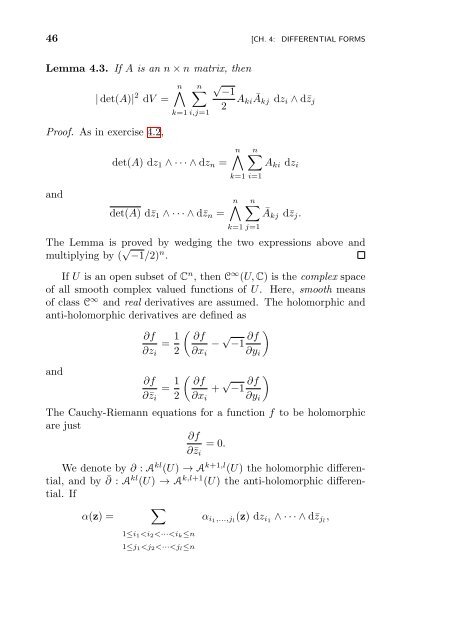Nonlinear Equations - UFRJ
Nonlinear Equations - UFRJ
Nonlinear Equations - UFRJ
You also want an ePaper? Increase the reach of your titles
YUMPU automatically turns print PDFs into web optimized ePapers that Google loves.
46 [CH. 4: DIFFERENTIAL FORMS<br />
Lemma 4.3. If A is an n × n matrix, then<br />
√ n∧ n∑ −1<br />
| det(A)| 2 dV =<br />
2 A kiĀkj dz i ∧ d¯z j<br />
Proof. As in exercise 4.2,<br />
and<br />
k=1 i,j=1<br />
det(A) dz 1 ∧ · · · ∧ dz n =<br />
det(A) d¯z 1 ∧ · · · ∧ d¯z n =<br />
n∧<br />
k=1 i=1<br />
n∧<br />
k=1 j=1<br />
n∑<br />
A ki dz i<br />
n∑<br />
Ā kj d¯z j .<br />
The Lemma is proved by wedging the two expressions above and<br />
multiplying by ( √ −1/2) n .<br />
If U is an open subset of C n , then C ∞ (U, C) is the complex space<br />
of all smooth complex valued functions of U. Here, smooth means<br />
of class C ∞ and real derivatives are assumed. The holomorphic and<br />
anti-holomorphic derivatives are defined as<br />
and<br />
∂f<br />
∂z i<br />
= 1 2<br />
( ∂f<br />
∂x i<br />
− √ −1 ∂f<br />
∂y i<br />
)<br />
∂f<br />
= 1 ( ∂f<br />
+ √ −1 ∂f )<br />
∂¯z i 2 ∂x i ∂y i<br />
The Cauchy-Riemann equations for a function f to be holomorphic<br />
are just<br />
∂f<br />
∂¯z i<br />
= 0.<br />
We denote by ∂ : A kl (U) → A k+1,l (U) the holomorphic differential,<br />
and by ¯∂ : A kl (U) → A k,l+1 (U) the anti-holomorphic differential.<br />
If<br />
∑<br />
α(z) =<br />
α i1,...,j l<br />
(z) dz i1 ∧ · · · ∧ d¯z jl ,<br />
1≤i 1

















